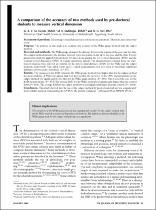A comparison of the accuracy of two methods used by pre-doctoral students to measure vertical dimension
Abstract
Statement of problem. Measuring vertical dimension is a soft-tissue measurement. Therefore, inaccuracy may
occur.
Purpose. The purpose of this study is to compare the accuracy of the Willis gauge method with the caliper
method.
Material and methods. The Willis gauge measures the distance between the septum of the nose and the chin.
The caliper method measures the distance between reference points on the tip of the nose and the chin. Twenty
predoctoral students applied both methods 10 times in measuring the rest vertical dimension (RVD) and the
occlusal vertical dimension (OVD) of a single edentulous patient. The measurements obtained from one experienced clinician were selected as controls for the interocclusal distances (IOD) for the Willis and the caliper
methods, respectively. One-sided t tests and a 1-sided nonparametric test were used to determine significant
differences between the 2 methods ( .05).
Results. The variances in the RVD values for the Willis gauge method were higher than for the caliper method
for most students. A Wilcoxon signed rank test showed that the accuracy of the OVD measurements for the
caliper method was significantly better than for the Willis gauge method (P .001). This was not the case for the
RVD measurements (P .073).The average IOD for the Willis method was significantly higher than the control
IOD (P .026). The average IOD for the caliper method was not significantly larger than the control (P .1303).
Conclusion. This study showed that the use of the caliper method by predoctoral students was a significantly
more reliable method of measuring the OVD for the patient evaluated

